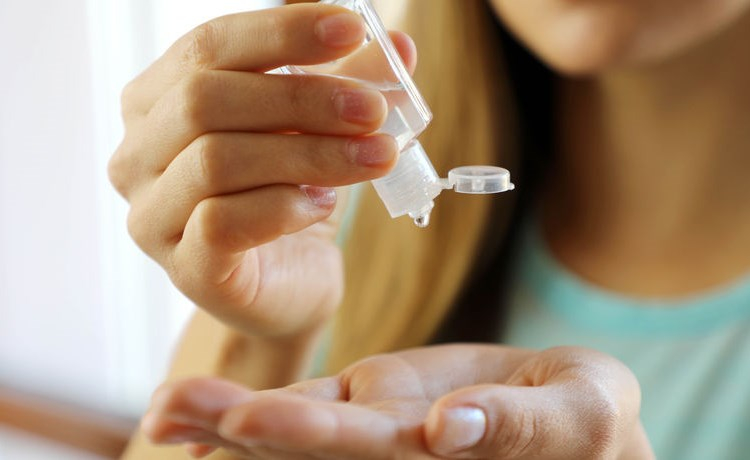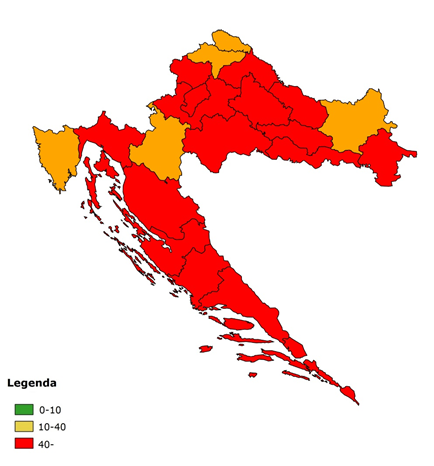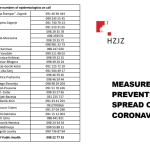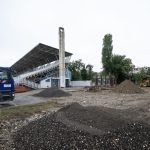
September 13, 2020 – The latest official COVID-19 in Croatia weekly report has been released by the Koronavirus government website, covering September 1-7.
CIPH report for the previous 7 days and daily report for the Republic of Croatia on the 7th of September 2020.
| Confirmed cases 12081 |
Recovered 9266 |
Deaths 201 |
Active cases 2614 |
| Tested 193153 |
Hospitalized 307 |
On a respirator 19 |
Self-isolation 9109 |
A total of 94 people died in this epidemic wave. Most of the deceased had significant comorbidities or were of advanced age. The average age of the deceased in this epidemic wave is 76.4 years. Thirty – eight people died on a respirator.
There are currently 22 testing places in the Republic of Croatia that perform RT-PCR analysis and collect samples. All processed samples enter national Croatian Health Insurance Institute platform, which is accessible to all county public health institutes. County public health institutes submit data about positive cases, sources of infection and hotspots as part of their daily reports to the Croatian Institute of Public Health. The Croatian Institute of Public Health collects information about hotspots, hospital treatment of COVID-19 positive persons, COVID-19 positive patients on respirators and the deceased. You can find more about the test centers on the link.
Epidemiological indicators on 7 th of September
- Cumulative 7-day rate for the Republic of Croatia: 44,3/100 000
- Cumulative 14-day rate for the Republic of Croatia: 92,2/100 000
- Counties with a cumulative 7-day rate greater than 50/100 000 inhabitants: Bjelovarsko-bilogorska, Dubrovačko-neretvanska, Požeško-slavonska, Splitsko-dalmatinska, Šibensko-kninska, Zadarska
- Counties with a cumulative 14- day rate greater than 100/100 000 inhabitants: Brodsko-posavska, Dubrovačko-neretvanska, Požeško-slavonska, Splitsko-dalmatinska, Šibensko-kninska, Zadarska
- Total number of tests in the last week: 24 924
- Share of positive tests in the total number of tests in the last week: 7,3 %
- Total number of tests and share of positive tests in total number of tests: 193 153, 6,3 %
- The number of new cases in intensive care per 100,000 inhabitants in the last 7 days: 0,4/100 000
- Number of deaths in the last week: 15
- Total death rate per 1 000 000 population: 49,2/1 000 000
Geographical distribution of new COVID-19 cases by counties
In the period from 24th of August to 7th of September all counties recorded new cases of COVID-19 disease. The highest number of new cases are recorded in the Splitsko – dalmatinska County, followed by the City of Zagreb and Zadarska County. The lowest number of new cases were recorded in Međimurska and Karlovačka County. The Splitsko – dalmatinska County also has the highest 14-day rate, followed by the Šibensko – kninska and Dubrovačko-neretvanska County.

| CITY OF ZAGREB | 94,1 |
| BBC | 58,4 |
| BPC | 109,9 |
| DNC | 158,4 |
| ISTARSKA C. | 38,8 |
| KARLOVAČKA C. | 24,0 |
| KKC | 43,6 |
| KZC | 43,1 |
| LSC | 84,1 |
| MEĐIMURSKA C. | 25,5 |
| OBC | 32,8 |
| PSC | 129,7 |
| PGC | 57,0 |
| SMC | 53,8 |
| SDC | 267,1 |
| ŠKC | 160,8 |
| VARAŽDINSKA C. | 30,5 |
| VPC | 59,8 |
| VSC | 51,8 |
| ZADARSKA C. | 122,5 |
| ZAGREBAČKA C. | 54,0 |
| TOTAL | 92,2 |
Figure 1. 14-day rate by counties
Epidemic by weeks, from 19 th – 28 th week of the epidemic
In the period from 29 th of June to 6th of September 2020, the number of cases per week (from the 19 th to the 28 th week of the epidemic) was from 460 to 1,948 and the rate from 11.3 to 47.6 per 100,000 inhabitants. The number of tests performed per week was ranged from 7,957 to 24,722 and the share of positive tests in those tested per week ranged from 5.8 to 12.5%. During this period, the weekly number of cases and the percentage of positive tests in the weekly number of tested varied. An overview is given in Table 1.

Table 1. Overview of the number of confirmed cases by weeks, from week 19 th – 28 th
In the period from 29 th of June to 6th of September 2020, the number of cases per week (from the 19 th to the 28th week of the epidemic) was from 460 to 1948. The number of deceased varied from 6-9 and showed increase in the number compared to 22nd, 23 rd , 27 th and 28 th week of the epidemic. The share of deceased on the respirator ranged in the weekly number of deaths from 16.7-60%. The mean age of deceased was 75 years or more, except in the 21 st week of the epidemic, when the mean age of death cases was 72,7 years. The death rate ranged from 0.1 in the 19 th week of the epidemic to 0.2 in the 27 th week of the epidemic with an increase in the 22 nd, 23 rd and 28 th week of the epidemic when it was 0.4 and 0.3. An overview is given in Table 2.

Table 2. Overview of patients on respirator and deaths by weeks, from week 19 th – 28 th
Table 3 shows the incidence of the 7-day rate in the last week with a limit of 50/100 000 inhabitants, which in some countries is taken as one of the criteria in assessing the epidemiological situation. In most counties, the 7-day rate is generally stable or slightly declining, while a significant jump in the 7-day rate was recorded in Dubrovačko – neretvanska County.

Table 3. Overview of 7-day incidence rates per 100,000 population in the last week
Clinical aspects – hospitalized, on a respirator and cured in the last week
Figure 2 shows the relationship between the daily number of confirmed cases and the daily number of hospitalized cases. Number of hospitalized cases per day ranged between a minimum of 24 and a maximum of 41, while the share of hospitalized cases in the total daily number of confirmed cases ranged from 8.9% to 21.4%.
Figure 2. Overview of the daily number of confirmed and hospitalized cases (1.-7.9.)
Figure 3 shows the proportion of hospitalized in the total number of weekly cases. In the last week, 230 people were hospitalized, which is 12.7% of the total number of patients in the given period. In the same period, 18 people were put on a respirator, which makes 1% of the total number of confirmed cases.
Figure 3. Relation of the total number of confirmed and hospitalized cases (1.-7.9.)

Figure 4. Movement of the total number of cases, recovered, deceased and active number of cases from 18.6.- 7.9.
Died from COVID-19, 29 th of June – 24 th of August 2020, age and sex
A total of 94 people died in this wave of epidemics. Most of the people who died had significant comorbidities or were of advanced age. The mean age of the deceased in this wave of epidemics is 74.6 years. Thirty – eight people died on a respirator.
An overview of the situation is given in Table 4 and Figure 5.
| AGE GROUP | 50-59 | 60-69 | 70-79 | 80-89 | 90-99 | 100+ |
| MEN | 5 | 14 | 24 | 11 | 1 | 0 |
| WOMEN | 0 | 4 | 7 | 22 | 5 | 1 |
Table 4. Distribution by age and sex of the deceased people

Figure 5. Age and sex distribution of deaths from COVID-19 in the period 29 th June – 31st August 2020
In the last week, 15 people died, of which 8 (53.3%) were on a respirator. The distribution by age and sex in the last weeks is shown in Table 5, and by counties in Table 6.
| AGE GROUP | 60-69 | 70-79 | 80-89 | 90-99 |
| MEN | 2 | 1 | 4 | 3 |
| WOMEN | 0 | 1 | 1 | 3 |
Table 6. Distribution by age and sex of the deceased people in the last week
| County | Number of new cases in the period 18.8.-24.8. | Incidence of new cases in the last 7 days on 100 000 inhabitants |
Number of deaths in the period 18/8/2020-24/8/2020 | Total number of deaths | Total mortality rate on 1,000,000 inhabitants |
|
| CITY OF ZAGREB | 337 | 41,9 | 2 | 28 | 34,8 | |
| BJELOVARSKO-BILOGORSKA COUNTY | 54 | 50,0 | 0 | 1 | 9,3 | |
| BRODSKO-POSAVSKA COUNTY | 62 | 44,3 | 0 | 3 | 21,4 | |
| DUBROVAČKO-NERETVANSKA COUNTY | 125 | 103,1 | 1 | 9 | 74,2 | |
| ISTARSKA COUNTY | 37 | 17,7 | 0 | 12 | 57,5 | |
| KARLOVAČKA COUNTY | 17 | 14,6 | 0 | 2 | 17,1 | |
| KOPRIVNIČKO-KRIŽEVAČKA COUNTY | 30 | 27,9 | 0 | 16 | 148,5 | |
| KRAPINSKO-ZAGORSKA COUNTY | 26 | 20,7 | 0 | 2 | 16,0 | |
| LIČKO-SENJSKA COUNTY | 23 | 50,9 | 0 | 1 | 22,1 | |
| MEĐIMURSKA COUNTY | 14 | 12,7 | 0 | 0 | 0,0 | |
| OSJEČKO-BARANJSKA COUNTY | 48 | 17,3 | 0 | 24 | 86,6 | |
| POŽEŠKO-SLAVONSKA COUNTY | 43 | 63,4 | 0 | 2 | 29,5 | |
| PRIMORSKO-GORANSKA COUNTY | 85 | 29,9 | 0 | 2 | 7,0 | |
| SISAČKO-MOSLAVAČKA COUNTY | 43 | 28,9 | 2 | 2 | 13,5 | |
| SPLITSKO-DALMATINSKA COUNTY | 524 | 116,9 | 7 | 56 | 125,0 | |
| ŠIBENSKO-KNINSKA COUNTY | 70 | 69,9 | 0 | 5 | 49,9 | |
| VARAŽDINSKA COUNTY | 25 | 15,0 | 0 | 3 | 18,0 | |
| VIROVITIČKO-PODRAVSKA COUNTY | 23 | 30,6 | 0 | 1 | 13,3 | |
| VUKOVARSKO-SRIJEMSKA COUNTY | 41 | 26,6 | 0 | 14 | 90,7 | |
| ZADARSKA COUNTY | 92 | 54,7 | 0 | 4 | 23,8 | |
| ZAGREBAČKA COUNTY | 93 | 30,1 | 3 | 14 | 45,2 | |
| UKUPNO | 1812 | 44,3 | 15 | 201 | 49,2 | |
Table 6. New ill and deceased cases in the last week and total deaths and rates
Hotspots
Continental Croatia
In the last week, new cases were recorded in all counties of continental Croatia, but mostly in the City of Zagreb, Zagrebačka and Brodsko – posavska County. The highest 7-day rates on 7 th of September were in Požeško – slavonska, Bjelovarsko – bilogorska and Brodsko – posavska County. In most counties, there is still influx of patients whose source of infection is associated with holidays on the Adriatic, and in connection with this, sick students who have returned from graduation trips are also recorded. Groupings were recorded around wedding celebrations in Bjelovarsko – bilogorska, Požeško – slavonska and Brodsko – posavska County. Smaller grouping in one company in Brodsko – posavska County was placed under supervision, as well as grouping in health care institutions in Brodsko – posavska, Karlovačka County and the City of Zagreb. Patients with COVID-19 were also registered in one institution for accommodation in social care in Sisačko – moslavačka County. In continental Croatia, a significant proportion of cases are contacts of previously patients or they are imported cases from Bosnia and Herzegovina.
Coastal Croatia
Cases of ill persons have been recorded in Coastal Croatia like in all counties as well. The highest number of patients was recorded in the Splitsko – dalmatinska, Dubrovačko – neretvanska and Zadarska County. The highest 7-day rate is in the Splitsko – dalmatinska, Dubrovačko – neretvanska and Šibensko – kninska County. In the Splitsko – dalmatinska County, smaller groupings were recorded in different departments of Clinical Hospital Centre Split, as well as in different types of service activities. In that county, the disease spread from a private gathering to a city institution and a bank department, but that hotspot soon came under the control. Also, smaller groupings were recorded as part of cultural events in the Primorsko – goranska and Šibensko – kninska County. Groupings of patients associated with wedding celebrations are also recorded in several counties of Coastal Croatia (Primorsko – goranska, Ličko – senjska and Dubrovačko – neretvanska County). A smaller grouping of patients in accommodation for the elderly in Zadarska County is also under supervision. As in the continental part of the country, a significant proportion of patients are contacts of previously recorded cases.
Start of working of educational institutions and sports activities
In Croatia, on September 7, all educational institutions started working at full capacity and another school year began with all the measures and recommendations that cover the educational system and which are designed and implemented precisely to protect the health of children and all employees in the best possible way. It is expected that with consistent adherence to measures and recommendations in all circumstances, this year in all educational institutions will take place without long interruptions. We still need to monitor the epidemiological situation on the ground very closely so that all further measures and recommendations can be planned and implemented in a right time. Due to the current situation of SARS-CoV-2 infection in several educational institutions, classes will be postponed or will take place online for the next ten days, until there aren’t conditions to start teaching in the classroom.
Sport is also important for health and good psychophysical development. It is therefore planned in cooperation with the Ministry of Tourism and Sports the continue of sports activities of children and young athletes and as well as professional athletes and sport clubs within sport halls that are an integral part of school facilities. Every term and every step in undertaking such activities and making decisions is closely monitored as well as their connection with the epidemiological situation and circumstances in a particular local area, county or region.
Age-sex distribution of patients in the last week
In the previous week, a total of 1,1812 people fell ill – approximately the same number of males, 891 (49.2%) and females, 921 (50.8%).
The same distribution by sex is present in most age groups, except in the age group up to 1 year where are only girls ill, age group 7-10 years (lower grades of primary school) where the share of ill girls is higher (16 or 59.3%), in the age group 11-14 years where the share of boys is higher (20 girls or 57.1%) and in the age group 15-18 years (high school) where the share of girls is higher (51 persons or 58.0%).
In other age groups, the share of patients of both sexes is the same, but there is a slight deviation in favor of women in the age groups 31-40 and 41-50 years of age, where more women became ill than men. This could be explained by the fact that women of that age are employed, are more represented in occupations that come into contact with the ill people or in the health care system, social welfare system or in those activities where they come into contact with other people (e.g. trade, tourism, public services).
By age groups, 203 children became ill and they made the smallest share (11.2%) in patients in the past week. The smallest number of ill people are children under the age of 1, a total of 4, and children in the lower grades of primary school, a total of 27. The most affected were children of high school age, 88 in total, or 4.8%.
In general, adults made the largest share in the total number of patients last week, i.e. 1399 (77.2%). A one fifth of patients (391 or 21.6%) in the last week are young adults, aged 19 to 30, which fits into the epidemiological situation where a significant proportion of patients are associated with holidays and going out to night clubs. However, as the number of patients associated with this source of infection decreases, the share of young adults decreased from one third to one fifth in the total share of patients. In contrast to previous weeks, there is a shift in the age of patients towards older age groups, so after young people aged 19-30, most patients are in the age group of 51-65 years (388 or 21.4%), followed by patients in the age group of 31 to 40 (320 or 17.7%) and 41-50 years of age (301 or 16.6%). The lowest number of adult patients is in the age group 66 and older (210 or 11.6%), although this number is not negligible, because in this group of patients is the highest number of concomitant comorbidities observed, which in COVID-19 patients are associated with an increased risk of development of a more severe clinical picture. The full view can be found in Figure 6 and Table 6.
| AGE GROUP | M | % | w | % | TOTAL | SHARE | |||
| KIDS | 0 | 0 | 0,0% | 4 | 100,0% | 4 | 203 | 0,2% | 11,2% |
| 1-6 | 26 | 53,1% | 23 | 46,9% | 49 | 2,7% | |||
| 7-10 | 11 | 40,7% | 16 | 59,3% | 27 | 1,5% | |||
| 11-14 | 20 | 57,1% | 15 | 42,9% | 35 | 1,9% | |||
| 15-18 | 37 | 42,0% | 51 | 58,0% | 88 | 4,9% | |||
| ADULTS | 19-30 | 204 | 52,2% | 187 | 47,8% | 391 | 1399 | 21,6% | 77,2% |
| 31-40 | 150 | 46,9% | 170 | 53,1% | 320 | 17,7% | |||
| 41-50 | 136 | 45,3% | 164 | 54,7% | 300 | 16,6% | |||
| 51-65 | 200 | 51,5% | 188 | 48,5% | 388 | 21,4% | |||
| ELDERS | 66+ | 107 | 51,0% | 103 | 49,0% | 210 | 210 | 11,6% | 11,6% |
| TOTAL | 891 | 49,2% | 921 | 50,8% | 1812 | 100,0% | |||
Table 6. Age and sex distribution of patients in the period 1.9.-7.9.2020
Measures
Measures to maintain physical distance, maintain hand hygiene and disinfection are still in force. Also, it is mandatory to wear face masks or medical masks indoors for all health workers and professionals, employees who work in social care system and the ones who work in hospitality facilities
Decisions of the Headquarters
- June 24 – Decision about changing the Decision on the manner of organizing public transport during the declared epidemic of the COVID-19 disease (mandatory face mask/medical mask in public transport)
- June 26 – Decision about controlling compliance with the Recommendation for the prevention of infection with COVID-19 in the catering industry of nightclubs (control of the implementation of recommendations in nightclubs)
- June 30 – Decision about a temporary prohibition on crossing the border of the Republic of Croatia (prohibition on crossing for third-country nationals, with the exception of those with long-term residence in the EU and other listed exceptions)
- July 10 – Decision about the necessary measures for the organization of gatherings attended by more than a hundred participants during the declared epidemic of the COVID-19 disease
- July 10 – Decision about the necessary measure of mandatory use of face masks or medical masks for the duration of the declared epidemic of the COVID-19 disease
- July 14 – Decision about changing the Decision on the necessary measure of mandatory use of face masks or medical masks for the duration of the declared epidemic of the COVID-19 disease
- July 14 – Decision about changing the Decision on the temporary prohibition on crossing the border crossings of the Republic of Croatia
- July 31 – Decision about changing the Decision on the temporary prohibition on crossing the border crossings of the Republic of Croatia
- August 13 – Decision about the necessary measure of limiting the working hours of hospitality facilities from the category bars /night clubs
- August 21 – Decision about amendment Decision on the necessary measure of limitation of working hours of hospitality facilities from the category “Bars”
- August 22 – Decision about introduction of necessary epidemiological measures for the area of the City of Imotski and the Municipalities of Cista Provo, Lovreć, Lokvičići, Podbablje, Proložac, Runovići, Zagvozd and Zmijavci
- August 25 – Decision about the introduction of the necessary epidemiological measure to limit wedding ceremonies for the Brodsko – posavska County
- August 26 – Decision about the introduction of necessary epidemiological measures for the Splitsko – dalmatinska County
- August 28 – Decision about the introduction of necessary epidemiological measures for the Zadarska County
- August 28 – Decision about the introduction of the necessary epidemiological measure of the manner of holding events, festivals and other events in the area of Međimurska County
- August 28 – Decision about the introduction of necessary epidemiological measures for the Dubrovačko – neretvanska County
- August 28 – Decision about the introduction of necessary epidemiological measures for the Brodsko – posavska County
- August 29 – Decision about the introduction of the necessary epidemiological measure to limit wedding ceremonies for the area of Virovitičko – podravska County
- August 29 – Decision about the introduction of necessary epidemiological measures for the Šibensko – kninska County
- August 29 – Decision about the introduction of the necessary epidemiological measure to limit wedding ceremonies for the area of Varaždinska County
- August 31 – Decision amending the Decision on the temporary ban on crossing the border crossings of the Republic of Croatia
- August 31 – Decision amending the Decision on the introduction of necessary epidemiological measures for the area of Splitsko – dalmatinska County
- September 2 – Decision about the introduction of necessary epidemiological measures for the Sisak-Moslavina County
- September 2 – Decision about the introduction of necessary epidemiological measures for the area of Požega-Slavonia County
- September 2 – Decision about the introduction of necessary epidemiological measures for the area of Koprivnica-Križevci County
- September 3 – Decision about the necessary measure of enhanced control of the implementation of the Guidelines for the Prevention and Suppression of the COVID-19 Epidemic for Social Service Providers in the Social Welfare System
- September 3 – Decision about the introduction of necessary epidemiological measures for the Krapina-Zagorje County
- September 5 – Decision about the introduction of necessary epidemiological measures for the Bjelovar-Bilogora County
- September 7 – Decision amending the Decision on the necessary measure of limiting the working hours of catering facilities in the category “Bars”
CIPH recommendations
- Recommendations for the prevention of COVID-19 infection in the activity of multiplex cinemas in shopping malls
- Instructions for the implementation of the state matriculation exam during the coronavirus epidemic (COVID-19) autumn deadline – August and September 2020
- Supplement to the recommendation for the prevention of COVID-19 infection in the catering industry of nightclubs
- Possibilities of conducting extracurricular classes related to the COVID-19 pandemic
- Instructions for prevention and suppression of the COVID-19 epidemic related to the work of preschool institutions, primary and secondary schools in the school year 2020/2021.
- Recommendations for manufacturers of textile masks intended for schools
- Guidelines for the prevention and control of the COVID-19 epidemic in student dormitories with regard to the COVID-19 epidemic in the school year 2020/2021.
- Recommendations for the operation of dance schools during the coronavirus epidemic (COVID-19)
- Recommendations for the operation of art schools during the coronavirus epidemic (COVID-19)
- Priorities for testing for SARS-CoV-2, on contact handling, completion of isolation and self-isolation (Consolidated revised recommendations)
- Diseases and health conditions that may increase the risk for more severe forms of COVID-19 disease
- Selected health and organizational issues related to the work of preschool institutions, primary and secondary schools in the school year 2020/2021
- Recommendations for teaching at higher education institutions in the period of the COVID-19 pandemic with the application of anti-epidemic measures
- Organization of rest and food – Work of preschool institutions, primary and secondary schools in the school year 2020/2021 – additional clarifications
Recommendations and measures on global and EU level
Europe
On 10 th of August 2020, ECDC released an updated version of the risk assessment.
ECDC has additional documents and information available:
https://www.ecdc.europa.eu/en
https://www.ecdc.europa.eu/en/covid-19-pandemic
The number of cases and the 7-day cumulative incidence of COVID-19 confirmed cases worldwide can be found on the ECDC dashboard.
Austria
Bundesministerium für Soziales, Gesundheit, Pflege und Konsumentenschutz.
Netherlands
Government of the Netherlands
National Institute for Public Health and the Environment
Germany
Rober Koch Institut
Slovenia
(gov.si)
National Institute for Public Health
United Kingdom
gov.uk
NHS
World
WHO provides comprehensive information and documents
WHO COVID-19-Dashboard
https://www.who.int/emergencies/diseases/novel-coronavirus-2019
Coronavirus disease (COVID-19) Weekly Epidemiological Update and Weekly Operational Update i Weekly Surveillance Report:
https://www.who.int/emergencies/diseases/novel-coronavirus-2019/situation-reports
https://www.euro.who.int/en/health-topics/health-emergencies/coronavirus-covid-19/weekly-surveillance-report
Sources of information
- https://www.hzjz.hr/
- https://zdravlje.gov.hr/
Information about the global epidemiological situation
More about COVID-19 in other countries can be found and learned on the ECDC website
The WHO Regional Office for Europe, the European Commission and the European Observatory on Health Systems and Health Policy have at their disposal the COVID-19 Health System Response Monitor (HSRM). There is information available about European countries and ways to respond to this epidemic. The focus is on health systems and public initiatives.
For the latest travel info, bookmark our main travel info article, which is updated daily.
Read the Croatian Travel Update in your language – now available in 24 languages!
Join the Total Croatia Travel INFO Viber community.









